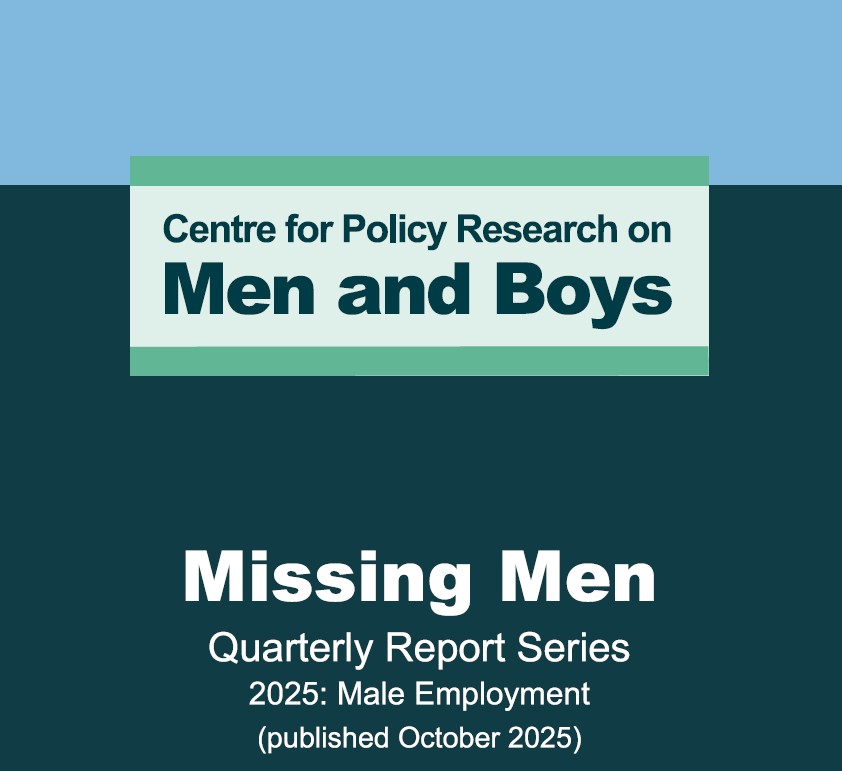
Download: Missing Men – Quarterly Report Series 2025 (Male Employment)
Press Release: CPRMB calls for “This Boy Cares” campaign to get men and boys back to work
12 October 2025
Executive Summary
Following the successful launch of the Missing Men: Men and Boys’ Scorecard (2024/25) in May 2025, for the last three quarters of each subsequent year, the CPRMB will produce a quarterly snapshot update on one of its key focus areas.
For this quarter, employment is the focus in alignment with the government’s Get Britain Working Strategy and its core pillars such as the Industrial Strategy, Local Growth Plans and the Youth Guarantee. The government is also due to publish a Men’s Health Strategy later this year, which will play a part in addressing working-age men, who are too ill to work.
This report focuses on five data sets – two at both ends of the age spectrum, two with respect to working-age employment sickness and the last on working hours. The focus is on how many and what types of men are ‘missing’ from the workplace – and analysing (using the business scorecard approach from the first report) the trends. Some of these men are unemployed, others economically inactive.
The current unemployment rate for men is 4.8% (aged 16 and over, Q2, 2025, UK), the highest rate since Q2 2021, and higher than in the immediate pre-pandemic period (Q1 2020) where it was 4.3%. Currently 886,000 million men are unemployed.
Findings
NEETS: Whilst there has been a year-on-year fall in the proportion of 16-24 year old young men who are Not in Education, Employment and Training (NEET), the overall proportion is higher than in the decades before the pandemic. It is welcome news that the unemployment rate for NEETS has not increased, remaining steady at 5.9% since the same quarter of 2024 and down considerably from its recent peak in 2010. However, the story is not the same for the proportion of NEETS who are now economically inactive (7.2%). Ten years ago it was 4.4% and 20 years ago 4.5%. In numbers there are currently 224,000 unemployed young men, all missing from the workforce. There are also an estimated 146,000 young men who are economically inactive due to temporary or long-term illness – many of whom are also potentially ‘missing’ from the workforce.
Working-age men aged 50+: Current rates of unemployment (3.5%) and economic inactivity (22%) are lower than the first half of this century. However, the rates are higher than the immediate pre-pandemic period (2.9% and 21.2% in 2019). There are 178,000 unemployed men in this age group. Using regional figures, if the employment rates in the three lowest performing regions were at the same level as the three highest, there would be 79,000 more 50+ men in the North West in work, 41,000 in Wales and 33,000 in the North East. All currently ‘missing’ from their local workforce.
Men who are long-term sick and want to work: Whilst the proportion of men in this category now (1.7%) is lower than the first half of this century, the rates are higher than the immediate pre-pandemic period (1.3%). There are currently 371,000 working age men who are long-term sick and want to work. All missing from the workforce.
Sickness Rates: Sickness rates for working age men have consistently fallen with 1.6% of male employed working hours lost to sickness (2.6% in 2000). The rate is the same now as before the pandemic and 4 days are lost per male worker per year. However, there has been an increase in the rate and number of days lost due to men being off work due to mental health. This is an estimated 1 million extra working days.
Long working hours (45+): The number of men working over 45 hours per week has nearly halved this century (from 36.2% in 2000 to 18.8% in 2025). A higher proportion of self-employed men (25.4%) work longer hours than male employees (17.6%). However, 3.3 million men and 1.4 million women still work long hours.
Analysis
Broadly, the employment picture for men had been improving throughout the century, up until the pandemic (March 2020 – end of 2021) since when it has worsened. This is illustrated by a combination of growth in unemployment and in economic inactivity.
There is a real opportunity to grow the male workforce. These include ‘sub-categories’ of men, especially NEETS, those aged over 50 and those who want to work yet are long-term sick. Growth is needed to meet the government’s target of an 80% employment rate which the CPRMB has previously estimated requires an extra 975,000 men in employment.
Policy Recommendations
The Government’s Get Britain Working plan has clear policy delivery pillars which are underway including the Youth Guarantee and Keep Britain Working Review to support employers in tackling health based economic inactivity. All pillars should understand and address any specific barriers that are affecting the economic activity, participation and productivity of men. The same should be included in the implementation of the UK Modern Industrial Strategy.
The forthcoming Department for Education’s schools’ white paper should apply a gender-sensitive lens so it can focus on boys’ relative under-attainment (such an approach was outlined in All-Party Parliamentary Group report[v] in 2023); creating a careers service and campaigns that actively promotes non-traditional ‘male’ careers such as in teaching, health and social care; and better prepares young men and boys for further vocational education. These campaigns and promotions could all be branded under the overall banner of “This Boy Cares” as a general message, and made specific to individual job paths as described above. There should be specific recruitment campaigns targeting men of all ages to go into these careers too.
The forthcoming Men’s Health Strategy should have a clear targeted mission to reduce male economic inactivity due to ill-health; improve the take up of the men’s health check (there are already pilots being run with employers); and increase the volumes of men working in the health and social care sector.